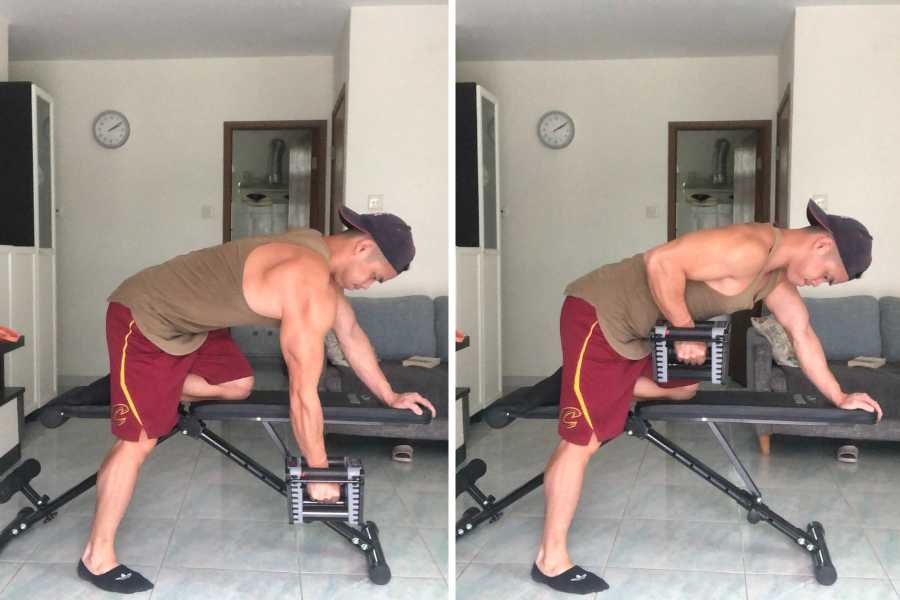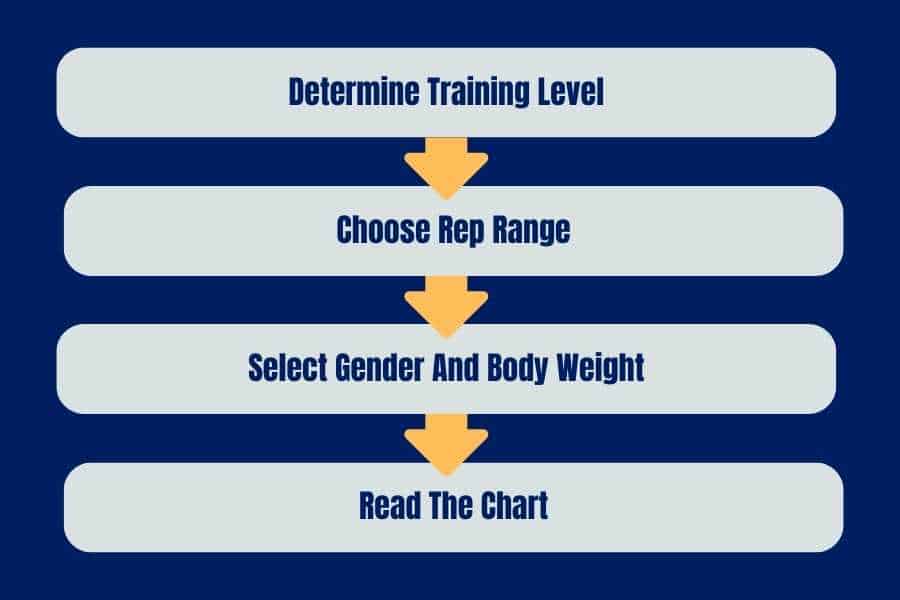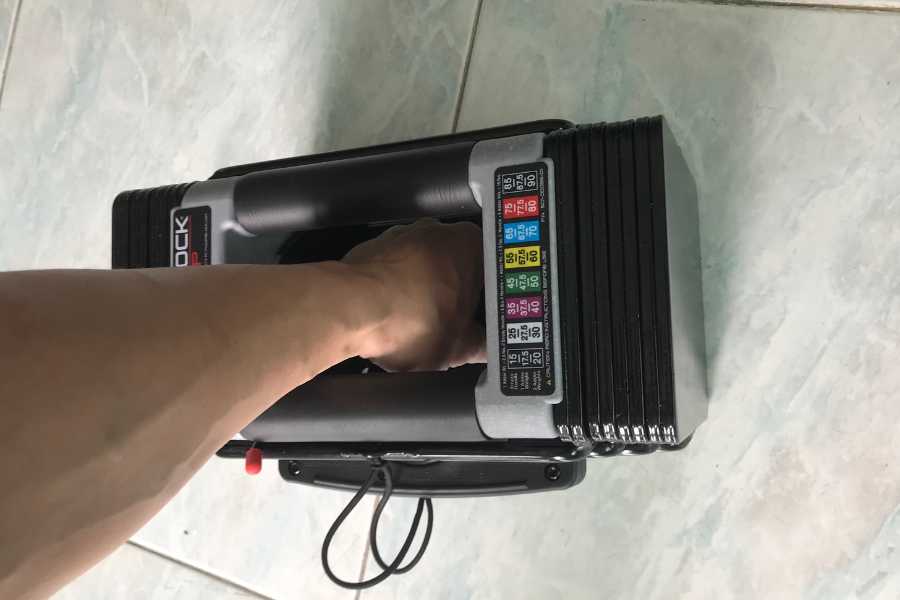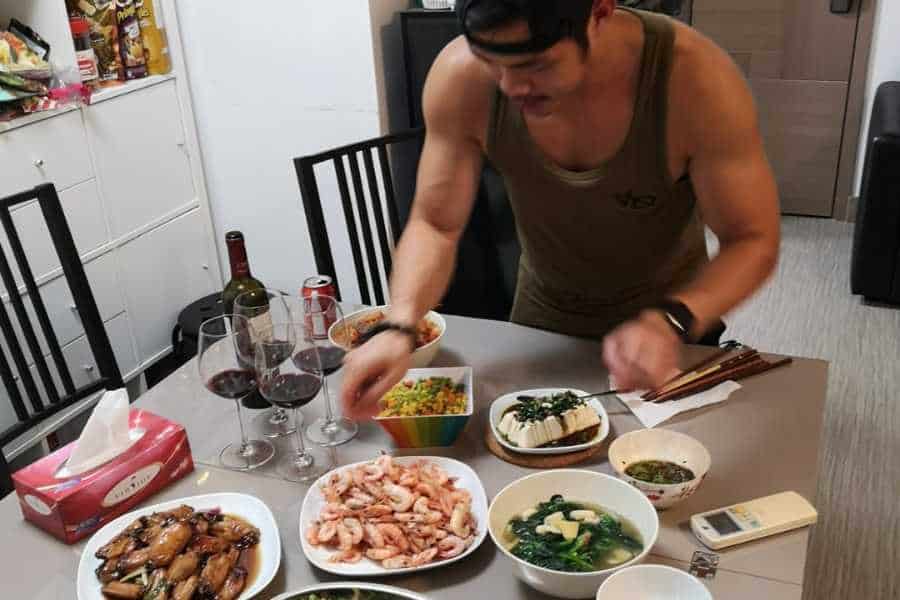To make the most out of your dumbbell rows, you need to be lifting the right amount of weight. But this varies from person to person. Below, I reveal dumbbell row standards to help you decide how much weight to lift.
A respectable dumbbell row for beginners is around 30% of body weight for 1 repetition. In contrast, intermediates should be able to row 85%- and advanced lifters 120%- of body weight. Switching to the one-arm row variation usually decreases these standards by 30%.
The weight standards in this post will help you determine what is a respectable weight to be rowing and how much weight you should be lifting based on your gender, body weight, and training experience.
- Types Of Dumbbell Row
- How To Use These Weight Standards
- Beginner Dumbbell Row Weight Standards
- Intermediate Dumbbell Row Weight Standards
- Advanced Dumbbell Row Weight Standards
- How Good Is Your Dumbbell Row Vs Others?
- Beginner One-Arm Dumbbell Row Weight Standards
- Intermediate One-Arm Dumbbell Row Weight Standards
- Advanced One-Arm Dumbbell Row Weight Standards
- How Good Is Your One-Arm Row Vs Others?
- Factors Affecting How Much Weight You Can Dumbbell Row
- 5 Reasons Why Your Dumbbell Row Weight Is Below Average
- Other Weight Standards For Dumbbell Row Muscles
- Conclusion
Types Of Dumbbell Row
For the purpose of definition, this post covers weight standards for the two main rowing variations that you can do with dumbbells:
- Bent-over dumbbell row.
- One-arm dumbbell row.
The bent-over row uses two dumbbells and utilizes an overhand grip. This variation will be referred to as a “dumbbell row” from here onwards.

The one-arm (also called single-arm) row uses one dumbbell and utilizes a hammer grip. This variation will be referred to as a “one-arm row” from here onwards.

How To Use These Weight Standards

1) Determining your training level:
- Beginners have practiced the row for 1-12 months.
- Intermediates have practiced the row for 12-36 months.
- Advanced lifters have practiced the row for 4 years or more.
2) Choosing your rep range:
The weight standards are given for:
- 1-rep max (1RM)- this is the maximum amount of weight you can lift for a single repetition. It’s often used as a strength standard.
- 6-10 working reps- this is generally considered to be the ideal rep range for building muscle.
3) Selecting your gender and body weight:
- Average dumbbell row weight standards are revealed for common body weights.
- Male dumbbell row weight standards are given.
- Females can use a 60% conversion (multiply the weight standard by 0.60).
4) Reading the charts:
- Weight standards are given as lbs on the top and kg on the bottom.
- If you’re dumbbell rowing at or above the weight standard for your given training level, body weight, and gender, then you are lifting a respectable amount of weight.
Beginner Dumbbell Row Weight Standards
Here’s how much weight you should be lifting on the dumbbell row as a beginner:
| Bodyweight | 1-rep max | 6-rep max | 7-rep max | 8-rep max | 9-rep max | 10-rep max |
|---|---|---|---|---|---|---|
| 120lb 54kg | 24lb 11kg | 20lb 9kg | 20lb 9kg | 19lb 9kg | 19lb 8kg | 18lb 8kg |
| 150lb 68kg | 42lb 19kg | 35lb 16kg | 34lb 16kg | 34lb 15kg | 33lb 15kg | 31lb 14kg |
| 200lb 91kg | 74lb 34kg | 62lb 28kg | 61lb 28kg | 59lb 27kg | 58lb 26kg | 54lb 24kg |
| 250lb 113kg | 106lb 48kg | 89lb 40kg | 87lb 39kg | 85lb 38kg | 83lb 37kg | 77lb 35kg |
| 300lb 136kg | 134lb 61kg | 113lb 51kg | 110lb 50kg | 107lb 49kg | 105lb 47kg | 98lb 44kg |
Generally speaking, beginners should be able to dumbbell row 20 to 45% of their body weight for a single repetition (1-rep max).
Intermediate Dumbbell Row Weight Standards
Here’s how much weight you should be lifting on the dumbbell row as an intermediate lifter:
| Bodyweight | 1-rep max | 6-rep max | 7-rep max | 8-rep max | 9-rep max | 10-rep max |
|---|---|---|---|---|---|---|
| 120lb 54kg | 92lb 42kg | 77lb 35kg | 75lb 34kg | 74lb 33kg | 72lb 33kg | 67lb 30kg |
| 150lb 68kg | 126lb 57kg | 106lb 48kg | 103lb 47kg | 101lb 46kg | 98lb 45kg | 92lb 42kg |
| 200lb 91kg | 176lb 80kg | 148lb 67kg | 144lb 65kg | 141lb 64kg | 137lb 62kg | 128lb 58kg |
| 250lb 113kg | 222lb 101kg | 186lb 85kg | 182lb 83kg | 178lb 81kg | 173lb 79kg | 162lb 73kg |
| 300lb 136kg | 264lb 120kg | 222lb 101kg | 216lb 98kg | 211lb 96kg | 206lb 93kg | 193lb 87kg |
Generally speaking, intermediates should be able to dumbbell row 75 to 90% of their body weight for a single repetition.
Advanced Dumbbell Row Weight Standards
Here’s how much weight you should be lifting on the dumbbell row as an advanced lifter:
| Bodyweight | 1-rep max | 6-rep max | 7-rep max | 8-rep max | 9-rep max | 10-rep max |
|---|---|---|---|---|---|---|
| 120lb 54kg | 142lb 64kg | 119lb 54kg | 116lb 53kg | 114lb 52kg | 111lb 50kg | 104lb 47kg |
| 150lb 68kg | 184lb 83kg | 155lb 70kg | 151lb 68kg | 147lb 67kg | 144lb 65kg | 134lb 61kg |
| 200lb 91kg | 246lb 112kg | 207lb 94kg | 202lb 91kg | 197lb 89kg | 192lb 87kg | 180lb 81kg |
| 250lb 113kg | 300lb 136kg | 252lb 114kg | 246lb 112kg | 240lb 109kg | 234lb 106kg | 219lb 99kg |
| 300lb 136kg | 348lb 158kg | 292lb 133kg | 285lb 129kg | 278lb 126kg | 271lb 123kg | 254lb 115kg |
Generally speaking, an advanced lifter should be able to dumbbell row 115 to 120% of their body weight for a single repetition.
How Good Is Your Dumbbell Row Vs Others?
Here’s the average percentage of people who can dumbbell row their own body weight:
| Dumbbell Row 1RM Weight (as a fraction of body weight) | % Of People Who Can Do It |
|---|---|
| 0.10x | 100% |
| 0.20x | 99% |
| 0.30x | 97% |
| 0.40x | 94% |
| 0.50x | 88% |
| 0.60x | 79% |
| 0.70x | 70% |
| 0.80x | 59% |
| 0.90x | 48% |
| 1.00x | 38% |
| 1.10x | 29% |
| 1.20x | 22% |
| 1.30x | 16% |
| 1.40x | 11% |
| 1.50x | 8% |
| 1.60x | 5% |
| 1.70x | 3% |
| 1.80x | 2% |
| 1.90x | 1% |
| 2.00x | 0.99 |
This allows you to compare your standards with others.
To calculate your dumbbell row as a fraction of your own body weight, simply divide the weight of your 1RM by your body weight.
For example: if you weigh 200lbs and your row 1RM is 100lbs, then you’re lifting 0.50x your body weight (75lbs ÷ 150lbs).
The above chart indicates:
- 75% of people can dumbbell row 0.65x their body weight for 1 rep. This represents the lower quartile of lifters and is a respectable weight for beginners to achieve.
- 50% of people can dumbbell row 0.90x their body weight for 1 rep. This represents the median quartile of lifters and is a respectable weight for intermediates to achieve. It’s also a realistic target for beginners to aim towards with enough training.
- 25% of people can dumbbell row 1.15x their body weight for 1 rep. This represents the upper quartile of lifters and is a respectable weight for advanced lifters. It’s also a realistic target for intermediates to aim towards with enough training.
Beginner One-Arm Dumbbell Row Weight Standards
Here’s how much weight you should be lifting on the one-arm row as a beginner:
| Bodyweight | 1-rep max | 6-rep max | 7-rep max | 8-rep max | 9-rep max | 10-rep max |
|---|---|---|---|---|---|---|
| 120lb 54kg | 19lb 9kg | 16lb 7kg | 16lb 7kg | 15lb 7kg | 15lb 7kg | 14lb 6kg |
| 150lb 68kg | 30lb 14kg | 25lb 11kg | 25lb 11kg | 24lb 11kg | 23lb 11kg | 22lb 10kg |
| 200lb 91kg | 48lb 22kg | 40lb 18kg | 39b 18kg | 38lb 17kg | 37lb 17kg | 35lb 16kg |
| 250lb 113kg | 64lb 29kg | 54lb 24kg | 52lb 24kg | 51lb 23kg | 50lb 23kg | 47lb 21kg |
| 300lb 136kg | 80lb 36kg | 67lb 30kg | 66lb 30kg | 64lb 29kg | 62lb 28kg | 58lb 26kg |
Generally speaking, beginners should be able to one-arm row 15 to 25% of their body weight for a single repetition (1-rep max).
Intermediate One-Arm Dumbbell Row Weight Standards
Here’s how much weight you should be lifting on the one-arm row as an intermediate lifter:
| Bodyweight | 1-rep max | 6-rep max | 7-rep max | 8-rep max | 9-rep max | 10-rep max |
|---|---|---|---|---|---|---|
| 120lb 54kg | 61lb 28kg | 51lb 23kg | 50lb 23kg | 49lb 22kg | 48lb 22kg | 45lb 20kg |
| 150lb 68kg | 79lb 36kg | 66lb 30kg | 65lb 29kg | 63lb 29kg | 62lb 28kg | 58lb 26kg |
| 200lb 91kg | 107lb 49kg | 90lb 41kg | 88lb 40kg | 86lb 39kg | 83lb 38kg | 78lb 35kg |
| 250lb 113kg | 131lb 59kg | 110lb 50kg | 107lb 49kg | 105lb 48kg | 102lb 46kg | 96lb 43kg |
| 300lb 136kg | 153lb 69kg | 129lb 58kg | 125lb 57kg | 122lb 56kg | 119lb 54kg | 112lb 51kg |
Generally speaking, intermediates should be able to one-arm row 50% of their body weight for a single repetition.
Advanced One-Arm Dumbbell Row Weight Standards
Here’s how much weight you should be lifting on the one-arm row as an advanced lifter :
| Bodyweight | 1-rep max | 6-rep max | 7-rep max | 8-rep max | 9-rep max | 10-rep max |
|---|---|---|---|---|---|---|
| 120lb 54kg | 91lb 41kg | 76lb 35kg | 75lb 34kg | 73lb 33kg | 71lb 32kg | 66lb 30kg |
| 150lb 68kg | 114lb 52kg | 96lb 43kg | 93lb 42kg | 91lb 41kg | 89lb 40kg | 83lb 38kg |
| 200lb 91kg | 146lb 66kg | 123lb 56kg | 120lb 54kg | 117lb 53kg | 114lb 52kg | 107lb 48kg |
| 250lb 113kg | 175lb 79kg | 147lb 67kg | 144lb 65kg | 140lb 63kg | 137lb 62kg | 128lb 58kg |
| 300lb 136kg | 200lb 91kg | 168lb 76kg | 164lb 74kg | 160lb 73kg | 156lb 71kg | 146lb 66kg |
Generally speaking, an advanced lifter should be able to one-arm row 65 to 75% of their body weight for a single repetition.
How Good Is Your One-Arm Row Vs Others?
Here’s the average percentage of people who can one-arm row their own body weight:
| One-Arm Dumbbell Row 1RM Weight (as a fraction of body weight) | % Of People Who Can Do It |
|---|---|
| 0.05x | 100% |
| 0.10x | 100% |
| 0.15x | 100% |
| 0.20x | 99% |
| 0.25x | 97% |
| 0.30x | 91% |
| 0.35x | 81% |
| 0.40x | 69% |
| 0.45x | 54% |
| 0.50x | 40% |
| 0.55x | 27% |
| 0.60x | 17% |
| 0.65x | 10% |
| 0.70x | 6% |
| 0.75x | 3% |
| 0.80x | 2% |
| 0.85x | 0.8% |
| 0.90x | 0.4% |
| 0.95x | 0.2% |
| 1.00x | 0.1% |
The above chart indicates:
- 75% of people can one-arm row 0.40x their body weight for 1 rep. This represents the lower quartile of lifters and is a respectable weight for beginners to achieve.
- 50% of people can one-arm row 0.45x their body weight for 1 rep. This represents the median quartile of lifters and is a respectable weight for intermediates to achieve. It’s also a realistic target for beginners to aim towards with enough training.
- 25% of people can one-arm row 0.55x their body weight for 1 rep. This represents the upper quartile of lifters and is a respectable weight for advanced lifters. It’s also a realistic target for intermediates to aim towards with enough training.
Factors Affecting How Much Weight You Can Dumbbell Row
4 factors affect how much weight you can lift on a dumbbell row:
- Training Level. The longer you’ve been practicing the row the more weight you can lift.
- Gender. Men have more muscle mass and can generally row more than women.
- Body weight. The heavier you are the more weight you can row. That’s because body weight has a positive correlation with muscle mass and strength.
- Rep range. The fewer reps you do the more weight you can row.
5 Reasons Why Your Dumbbell Row Weight Is Below Average
Here are 5 common reasons why you may find the dumbbell row difficult to perform and why your weight standards are below average.
I’ve also shared solutions for each problem.
These solutions can help to improve your dumbbell row.
1) Incorrect lifting form

The dumbbell row is a relatively technical movement that requires you to use good form to gain the greatest leverage to lift the dumbbells.
If your form is off, you risk injuring your lower back (sometimes without even realizing it) and reducing the amount of force you can apply to the dumbbells.
As a result, your row strength progression can suffer and this can lead to below-average weights lifted.
Solution:
Keep a neutral straight lower back at all times (regardless of rowing variation). Additionally, brace your core before each row movement by; sucking in a deep breath of air, holding it in, and pushing your diaphragm outwards.
This keeps your body rigid and provides a strong foundation to lift from.
Also- remember the row is primarily a back exercise. Focus on pulling with your back rather than your arms. Do this by actively contracting your shoulder blades as you row.
For a better idea of what this looks like, you can check out my tutorial post for a list of dumbbell exercises for beginners (including form pointers).
2) Low grip strength

It’s crucial to have a strong grip if you are to lift heavy on any free-weight exercise (you need to be able to hold the dumbbell in order to row it right?).
But the muscles in your wrist and forearm that contribute to grip strength are relatively small and weak compared to your back and upper arms. Furthermore, beginners may not yet have developed the grip strength of seasoned lifters.
This can be a severely limiting factor in how much weight you can dumbbell row.
Solution:
Grip strength naturally develops with increased training experience. So be patient and keep practicing the dumbbell row.
Make sure you apply progressive overload by lifting increasingly heavier dumbbells over time.
Wrist straps can also help you to row heavier dumbbells. But this is not a long-term solution for beginners to build grip strength (you’re simply masking the problem with straps).
As a skinny beginner, I would focus on ACTUALLY building your grip strength by lifting heavy weights.
3) Weak primary drivers

The main target muscles for the row are the lats, rhomboids, trapezius, lower back, and posterior deltoids. These collectively form the back muscles.
Weak points in any of these muscles can lead to a below-average dumbbell row.
Solution:
The best way to get stronger on the row is to simply practice the movement more! Make sure you apply progressive overload regularly.
Additionally, do not forget to work the other muscles in your body.
Increasing full-body strength will increase the weight you can lift on most of the compound movements, including the row.
You can check out my other post for a complete full-body dumbbell workout plan for skinny guys (can be done at the gym or at home).
4) Weak secondary drivers and stabilizers

The row is a full-body movement that utilizes secondary muscles in addition to the primary drivers. The biceps serve as secondary drivers in the row, helping you to pull the dumbbell towards your torso.
Furthermore, numerous other muscles in the shoulders, legs, and core also engage to provide a stable foundation for you to row from.
Weakness in any of these muscle groups can lead to a below-average dumbbell row.
Solution:
As always, keep practicing the dumbbell row and focus on progressive overloading.
You can also perform back-isolation exercises like the reverse fly to build stronger rhomboids and posterior delts, or dumbbell curls to build stronger biceps.
These accessory movements can help to improve your dumbbell row.
5) Poor nutrition

You can be doing dumbbell rows with perfect form and applying the correct training volume. But if your diet is no good, then your strength gains will plateau very quickly.
Going on a bulking diet alongside your training is essential for building muscle and strength.
Solution:
Eat a 5-15% daily calorie surplus to fuel muscle growth. Consume at least 1g of protein per lb of body weight.
You can check out my 6 month transformation for more diet tips to gain muscle.
Other Weight Standards For Dumbbell Row Muscles
Rows are a horizontal compound pulling movement that primarily works the back muscles, but also the biceps too. Here are weight standards for other exercises that hit similar muscle groups:
- Pull-ups– vertical compound pulling exercise with emphasis on the lats and biceps. You can also check out my other post for pull-up world records!
- Reverse flyes– isolation-type exercise with emphasis on the rhomboids and posterior deltoids.
- Bicep curls– isolation-type exercises that target the biceps.
- Dumbbell deadlift– full-body compound pulling movement that works all of the back muscles.
Conclusion
I’ve given you dumbbell row weight standards based on my personal 5-years of experience in weight training.
If you’re lifting at- or exceeding- these standards, then you’re doing a good and respectable job.
I’ve also shared common problems and solutions regarding a below-average dumbbell row.
You may also be interested in the downloadable Kalibre Blueprint PDF which details exactly how I gained 40lbs of lean muscle (it’s 100% free!). It details the exact exercises and nutrition (with printables) I used to go from skinny to ripped!


